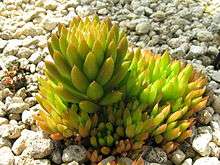Orostachys japonica
| Orostachys japonica | |
|---|---|
 | |
| Scientific classification | |
| Kingdom: | Plantae |
| (unranked): | Angiosperms |
| (unranked): | Eudicots |
| (unranked): | Core eudicots |
| Order: | Saxifragales |
| Family: | Crassulaceae |
| Genus: | Orostachys |
| Species: | O. japonica |
| Binomial name | |
| Orostachys japonica (Maxim.) A.Berger | |
Orostachys japonica (Japanese:爪蓮華、昭和、秀女)also known as rock pine is a species of flowering plant in the genus Orostachys. Native to Japan. Its main habitat is on the surface of mountain rocks in Korea and Japan,[1] and rocks on low mountains along streams in China.[2]
Ecology
Orostachys japonica is a biennial/perennial plant growing to 10 centimetres (3.9 in). It is in flower from September to October. The flowers are hermaphrodite. The rosette leaves shape like a spatula.[2]
- Suitable for: light sandy and loamy soils, prefers well-drained soil and can grow in nutritionally poor soil.
- Suitable pH: acid, neutral and basic alkaline soils.
Because of its growing shape which resembles a pine tree's cone, and its habit of growing on mountain rocks, it is also called rock pine.[1] It grows well in a sunny or semi-shaded(light woodland) location with a well-drained and moist soil that is low in nutrients. Its flowers bloom from September to October. The flowers are white and each flower has 5 conical petals. The flower lacks a peduncle. Its calyx is divided into 5 parts. When the flowers bloom and produce seeds, it dries out.

Medicinal uses
The leaves and stems contain several medically active constituents including fatty acid esters, Friedelin and flavonoids.[1] They are antispasmodic and cytotoxic. It strengthens the immune system of our body to produces specialized antibodies, preventing some disease. It has anti-cancer effect, suppressing the propagation of cancer cells. For this reason, it uses in the treatment of tumor and other disease. In Korea, they are used in the treatment of cancer, gingivitis, coagulation and metritis.[1]